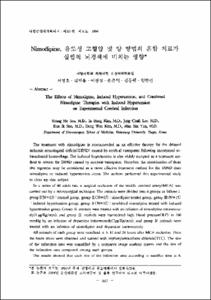KUMEL Repository
1. Journal Papers (연구논문)
1. School of Medicine (의과대학)
Dept. of Neurosurgery (신경외과학)
Nimodipine, 유동성 고혈압 및 양 방법의 혼합 치료가 실험적 뇌경색에 미치는 영향
- Alternative Author(s)
- Kim, In Hong; Lee, Jang Chull; Son, Eun Ik; Kim, Dong Won; Yim, Man Bin
- Journal Title
- 대한신경외과학회지
- ISSN
- 1225-8245
- Issued Date
- 1994
- Abstract
- The treatment with nimodipine is recommended as an effective therapy for the delayed ischemic neurological deficits(DIND) caused by cerebral vasospasm following aneurysmal subarachnoid hemorrhage. The induced hypertension is also widely accepted as a treatment method to reverse the DIND caused by cerebral vasospasm. Therefore, the combination of these two regimens may be considered as a more effective treatment method for the DIND than nimodipine or induced hypertension alone. The authors performed this experimental study to clear up this subject.
In a series of 60 adult rats, a surgical occlusion of the middle cerebral artery(MCA) was carried out by a microsurgical technique. The animals were divided into 4 groups as follows ; group Ⅰ(N=15) : control group, group Ⅱ(N=15) : nimodipine treated group, group Ⅲ(N=15) : induced hypertension group, group Ⅳ(N=15) : combined nimodipine treated with induced hyertension group. Group Ⅱ animals were treated with an infusion of nimodipine intravenously(1㎍/Kg/min), and group Ⅲ animals were maintained high blood pressure(B.P) to 160㎜Hg by an infusion of dopamine intravenously(2㎍/Kg/min), and group Ⅳ animals were treated with an infusion of nimodipine and dopamine intravenously.
All animals of each group were sacrificed at 6, 12 and 24 hours after MCA occlusion. Then the brain slices were obtained and stained with triphenyltetrazolium chloride(TTC). The size of the infarction area was quantified by a computer image analysis system and the size of the infarction area compared among each groups.
The results showed that each size of the infarction area according to sacrifice time at 6, 12 and 24 hours after MCA occlusion was significantly smaller in group Ⅱ, Ⅲ, Ⅳ than that of group Ⅰ(p<0.05). The total size of the infarction area was significantly smaller in group Ⅱ, Ⅲ and Ⅳ than that of group Ⅰ(group Ⅰ vs. Ⅱ vs. Ⅲ vs. Ⅳ ; 13.23±2.60 vs. 9.17±2.23 vs. 10.24±2.23 vs. 8.85±2.23%, respectively. group Ⅰ vs. Ⅱ, Ⅲ and Ⅳ : p<0.05). However, there was not noticed any significant difference in the size of the infarction area among group Ⅱ, Ⅲ and Ⅳ.
This study concludes that the treatment of the combined nimodipine with induced hypertension has no more benefit for the improving infarction in the permanent focal ischemic model than nimodipine or induced hypertension treatment alone.
저자들은 60마리의 흰쥐를 실험동물로 사용하여 측두하 접근으로 중대뇌동맥을 폐쇄하여 뇌경색을 유발하고, nimodipine 단독치료, 유도성 고혈압 단독치료, 혼합치료를 시행하여, 6시간, 12시간 및 24시간에 TTC 염색을 시행하여 뇌경색 크기를 측정하고 비교분석 하였다.
중대뇌동맥 폐쇄후 각 군간의 시간경과에 따른 뇌경색 크기는 nimodipine 치료군, 유도성 고혈압치료군, 혼합치료군에서 대조군에 비해 의미있게 감소되어 있었으며(p<0.05), 전체 뇌경색 크기의 평균치 역시 대조군에 비하여 nimodipine 치료군, 유도성 고혈압치료군, 혼합치료군에서 의미 있게 감소되어 있었다(p<0.05).
그러나 혼합치료군, nimodipine 치료군, 유도성 고혈압치료군 간의 비교에서는 혼합치료군에서 각각의 단독치료군보다 뇌경색 크기가 약간 더 감소하였으나, 통계학적 유의성있는 차이는 없었다. 따라서 이 실험의 결과로써는 임상에서 혼합치료가 nimodipine이나 유도성 고혈압 단독치료보다 효과가 우월하지는 않을 것으로 예측된다. 그러나 저자들의 뇌경색 모형이 영구성 국소 뇌경색 모형이었으므로 향후 가역성 뇌경색모형과 또한 뇌지주막하출혈을 유발한 동물실험에서 혼합치료의 효과를 더 추적 연구하는 것이 필요할 것으로 생각된다.
- Alternative Title
- The Effects of Nimodipine, Induced Hypertension, and Combined Nimodipine Therapies with Induced Hypertension on Experimental Cerebral Infarction
- Department
- Dept. of Neurosurgery (신경외과학)
- Publisher
- School of Medicine
- Citation
- 서영호 et al. (1994). Nimodipine, 유동성 고혈압 및 양 방법의 혼합 치료가 실험적 뇌경색에 미치는 영향. 대한신경외과학회지, 23(6), 607–614.
- Type
- Article
- ISSN
- 1225-8245
- Appears in Collections:
- 1. School of Medicine (의과대학) > Dept. of Neurosurgery (신경외과학)
- 파일 목록
-
-
Download
 oak-bbb-1666.pdf
기타 데이터 / 440.96 kB / Adobe PDF
oak-bbb-1666.pdf
기타 데이터 / 440.96 kB / Adobe PDF
-
Items in Repository are protected by copyright, with all rights reserved, unless otherwise indicated.